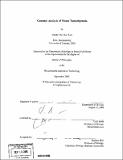Genomic analysis of mouse tumorigenesis
Author(s)
Tam, Mandy Chi-Mun
DownloadFull printable version (25.84Mb)
Other Contributors
Massachusetts Institute of Technology. Dept. of Biology.
Advisor
Tyler Jacks.
Terms of use
Metadata
Show full item recordAbstract
The availability of the human and mouse genome sequences has spurred a growing interest in analyzing mouse models of human cancer using genomic techniques. Comparative genomic studies on mouse and human tumors can be valuable in two major ways: in validating mouse models and in identifying genes that are common to mouse and human tumorigenesis. Many analytic tools have emerged in recent years for human genome mining. Some of these tools have been translated to the murine versions. The work in this thesis described the application of two new whole-genome analytic techniques to study mouse tumorigensis: Representational Oligonucleotide Microarray Analysis (ROMA) for tumor DNA copy number asessment and single nucleotide polymorphism (SNP) genotyping using the SNaPshotM system (Applied Biosystems) to detect loss of heterozygosity (LOH) in mouse tumors. The murine version of ROMA was tested on DNA from early-stage KrasGJ2D-derived lung cancers and metastatic retinoblastoma in mice with retinal-specific Rb and p130 deletions. We were interested in identifying the additional genetic lesions that got positively selected during tumorigenesis of these mice. (cont.) Several recurrent chromosomal copy number gains and losses were observed in the DNA of KrasGJ2D-derived lung tumors. In addition, a focal amplification of the murine N-Myc locus was detected in the metastatic retinoblastomas, demonstrating the capability of ROMA to detect copy number changes at a single-gene resolution. For genome-wide allelotyping, a panel of 147 mouse SNPs were individually validated in 129S4/SvJae vs. C57BL/6J strains and were chosen as markers in the genotyping panel. We worked out a multiplex protocol to genotype the SNPs in an efficient manner. Through this protocol, we generated low-density global LOH maps of lung tumors from mice expressing KrasG12D. LOH that spanned entire chromosomes was seen in a subset of the tumors. A loss of the wild-type p53 allele was also observed in some cases.
Description
Thesis (Ph. D.)--Massachusetts Institute of Technology, Dept. of Biology, 2006. Includes bibliographical references.
Date issued
2006Department
Massachusetts Institute of Technology. Department of BiologyPublisher
Massachusetts Institute of Technology
Keywords
Biology.